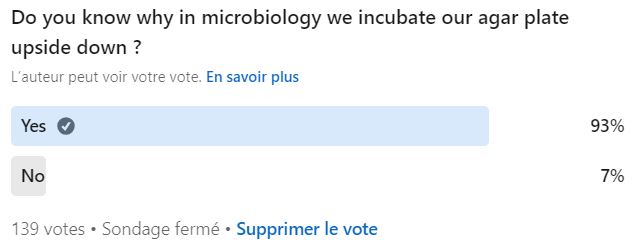Microbiologie : Why Incubate Petri Dishes Upside Down?
There are things we do every day in the lab without thinking much about them, simply because that’s how we were taught.
Then one morning, we wake up and wonder:
“Why on earth do we incubate Petri dishes upside down?”
Do bacteria enjoy doing somersaults, or is it all about gravity?
To solve this mystery, we asked the experts in the SuperMicrobiologistes community on LinkedIn. Because they know everything… proof here:

We’ve compiled their answers in this article.
Discover the 5 BEST Incubators
We polled the SuperMicrobiologists.
Here are their favorite Incubator
To avoid condensation
Culture media are mostly made of water. And what does water do in an incubator? It creates water vapor!
If we incubated our Petri dishes upright (lid on top), the water vapor would condense under the lid and form droplets. These droplets would fall onto our colonies, making plate readings… complicated.
To avoid contamination
Now, imagine that in addition to condensation, a tiny bit of contamination is hiding inside the Petri dish lid… The condensation would carry it down, dropping it onto the agar, and boom—contamination!
Should we incubate all Petri dishes inverted?
The answer is: Yes, unless… the supplier’s technical sheet specifies otherwise.
Contact plates (or RODAC plates), 90 mm plates, and even plates with a filtration membrane can be incubated upside down. And if the agar comes off, there’s an issue with the culture media (not because the plate are upside down !!).
However, there are some exceptions where the plate can be incubated right-side up.
Some media for yeast and mold are incubated with the lid facing up to avoid “ending up with invasive ‘hairy’ growths on the lid” (as one SuperMicrobiologist put it).
Anaerobic strains are incubated right-side up. This allows space between the dish and the lid for gas exchange, which removes oxygen. If the dish were upside down, condensation could act as an insulator, preventing gas exchange and disrupting the process.
And what about the standards?
Well, it’s written in black and white in the standards (at least the ones we have) that inoculated agar plates should be turned upside down before incubation, unless specific instructions say otherwise.
Here are two examples:
ISO 8199:20181, Chapter 9.1.5:
“Turn inoculated agar plates upside down and place them in an incubator…”
(translated from the french standard, original version might be slightly different)
ISO 7218:20242, Chapter 11.2.5:
“For bacterial counts, unless otherwise specified in specific standards, turn plates upside down immediately after the agar has solidified for pour plates, and once the agar is dry for surface-inoculated plates, and place them in an incubator at the appropriate temperature.”
(translated from the french standard, original version might be slightly different)
If you have other standards, especially in pharma (Pharmacopoeia), feel free to share them with us.
So, now you know why we (almost) always incubate our Petri dishes upside down. There’s a real logic behind it, and once you understand it, everything becomes much clearer!
Now it’s your turn—tell us how you incubate your culture media!













Leave a Reply
Want to join the discussion?Feel free to contribute!